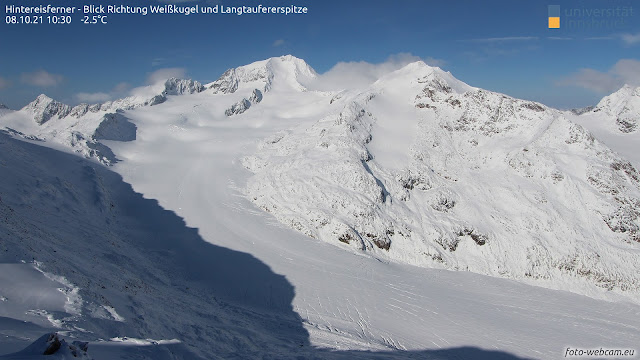Cold front brings snow to high alpine regions
Following stormy bouts with a southerly foehn wind, then a cold front, it turned wintery along the Main Alpine Ridge in Tirol. Between 04.10 and 07.10.2021, measurement stations registered generally between 20 and 80 mm of precipitation, in some cases more than 100 mm. However, due to initially above average temperatures, about half of that precipitation fell in the form of rain, ultimately resulting in about 40 cm of fresh snow currently in the hotspots. Those hotspots are the zone between southern Ötztal and Stubai Alps and western Zillertal Alps along the Main Alpine Ridge.
 |
| 72-hour difference in snow depth, 5-8 October 2022 |
Avalanches: not yet a big problem
Currently we assume that avalanches will be only a minor problem as a result of this round of fresh snowfall. At the focal point in the immediate future: small-sized loose-snow avalanches in rock-studded terrain in high alpine regions, particularly today (8 October) as soon as the sun comes out.
In high alpine regions, i.e. above approximately 3000 m, in shady very steep terrain where the old snow fields remained intact over the summer, and also where the snow from late August and mid-September did not melt, small-sized snowdrift accumulations might still be triggerable. However, this scenario will be the exception, not the rule. Moreover, the threat will be quite short lived. In a potential avalanche, the dangers of being forced to take a fall far outweigh other perils.
Time to brush up your sense of wintertime dangers
Nevertheless, the time is now starting when your sense of potential avalanche dangers and other alpine threats needs to be sharpened, e.g. the early-winter peril of falling into a crevice or striking against stones with your skis. After all, this is the season when the first, frequently quite unexpected accidents occur. An example of such an early winter mishap can be found here.
Currently, we do not have detailed information about the structure of the snowpack, i.e. layering in the old snowpack still present in glaciated terrain. But we assume that next to no weak layers have formed. We base this assumption on the weather conditions since late August and empirical re-visualizations of the processes which habitually unfold. For example, here is a brief reference:
 |
| Glaciers are still receding. Some old snowfields from last winter. Rear Jamtal (photo: 26.08.2021) |


